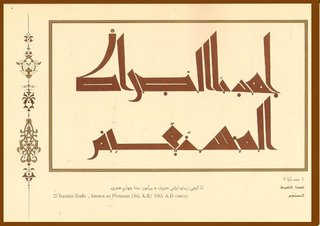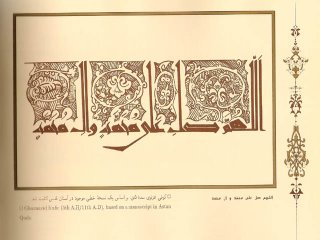IN THE MEMORY OF A GRAND TEACHER - USTAD MOHIT TABATABAI
The empty rock-frames of the Buddha statues in Bamiyan take observers to different thoughts with most of which I may take part. But for me there is also a particular cause to think, when I recall the memory of some happy days I spent there, many years ago; the days in companionship of a grand and honourable teacher, letterman and historian. And this is the story:
Many decades ago, when I was a grader student, I was fond of some literary programs broadcasted from radio. Among those programs, there was a historical lecture delivered on Thursdays’ afternoon. When I listened to the lectures, in his stentorian and expressive voice, I could not believe, even I could not imagine that in a far future I would met this professor, or we would travel together, or I would call him in his home, and he would receive me in his nineties. I took it as a God-gift, just to listen to him and learn every week many good new things from his lectures. The program was called The borders of knowledge, and the grand professor was Mohit Tabatabai.
In the evenings I had enough time for listening the radio, but the literary or historic programs that I liked, were broadcasted at the middays. There were popular literary programs during the nights, for me “The borders of knowledge” was a special gift. I should make it clear that this was the neighbour-relative’s radio that I had the permission to use it, and during the days I could have it easily. Every Thursday, returning from school, tired and hungry, the only thing to which I thought was listening to the program, “The borders of knowledge” that for me, was as an advanced class in literature and culture. When Professor Mohit was speaking, his voice came to my ears as the voice of an emperor who was the sovereign of the kingdom of knowledge. It was through his speeches that I found strong and holy meaning for the words of culture and literature. He spoke in full strength and he had dominance over the subjects on which he spoke. His articles also were published in some professional periodicals which we could read, or better to say, study. Those days passed. I left my home-city for Kabul to continue my high education. After graduation, I worked for many years in the Northern provinces as a journalist. It was about fifteen years after listening to the “Knowledge Borders” programs when I had the luck of seeing the grand teacher Mohit Tabatabai.
It was the summer of 1978 and I was working in the deportment of The Information and Culture as a member of the Historical society. One day the dean of the publication department called me and said: Ustad Mohit Tabatabai is on his way to Kabul. We are asked to send two persons to accompany him during his visit. The other person, whom they asked for, is not our employee. They may call him personally. He asked me if I agreed to be with the famous scholar and of course my response was yes. I did not only agree but also I was fond of seeing the scholar, whom I praised with so deep respect and reverence. Ustad arrived Kabul at due date. A schedule was made for visiting the historical as well as naturally beautiful places and landscapes. We went to Paghman, Karizmir and Stalif around Kabul. It was a great pleasure to see those beautiful places, accompanying such a great scholar. In every context he had a piece of knowledge, an epigram, or a verse. Thus, every second, one could learn something interesting and new from him.
After we visited certain places in Kabul, it was time to go to Ghazni, once the capital of poetry and literature, and the glorious centre of Ghaznavid Empire. There were four persons accompanying Ustad Mohit. Unfortunately I cannot recall the name of the driver who was one of the drivers from the Ministry of Information and Culture. Three others were Dr. Ravan Farhadi, Dr. Uussain Khadiv Jam and I. Khadiv Jam, famous writer and translator then was the cultural secretary of the Iranian embassy in Kabul. How great was watching the beauties of Ghazni and listening to the comments of that grand scholar. It was a rare opportunity I had found to be in company with three most learned scholars, particularly listening to Ustad Mohit’s comments and explanations on historical points which were vital for me to know. We visited most of Ghazni’s shrines and historical places during the day. Even though I had visited Ghazni and those shrines many times, on that day I thought as if I were visiting and discovering those places for the first time.
That was not all, because Ustad Mohit liked to see Bamian. On those days, traveling to Bamian was not easy. The roads to Bamian were barren and mountainous, not suitable for Ustad Mohit’s conditions. There, on those days we had in Kabul small planes called Twin Otter, which were used in civil flights. A Twin Otter plane was arranged to take Ustad Mohit and companions to Bamian. Fortunately the Governor of Bamian, on those days was Late Naqshband Dashti, a well-known teacher and man of culture, and the head of tourism in Bamian was Hassan Qassim, a young intellectual writer. He was also the manager of Bamian luxurious hotel. No doubt that Mr Qassim was very glad to see Ustad Mohit.
Twin Otter was a small light plane and when it got off the ground it swerved on the side that Ustad Mohit was sitting. The plane made a noise and Ustad cited a praying clause: O Salvager! Save us please. I remember that late Khadiv Jam said: Ustad, don’t worry. These are very good planes. Be sure we are safe. We flew over snowy mountains of central Afghanistan and landed in the city of Bamian. The scholarly governor of Bamian had come in person to the airport to welcome Ustad Mohit. During our staying there, the governor did whatever kindness he could. The guests were very comfortable in Bamian Hotel thank to kindness of Mr Qassim and Mrs Qassim. However it was not her duty, Mrs Qassim notwithstanding her little baby prepared delicious dishes for the grand guest. So being with an intellectual governor and a young writer- manager every thing in Bamian was in its best. Ustad liked to walk in Bamian. He walked and whenever he met folks, particularly children, he would stop and talk to them. He listened to every word carefully and it seemed he was comparing their speeches with the Persian classics. We went to see Buddha statues. He leaned on his cane and stared for long times to the tall awesome stature of the statues as if he were glancing the pages of the history. After 34 years, still I recall his thoughtfulness looks and his satiric smile there.
In addition to the statues, there were also other masterpieces in Bamian. Those were extremely beautiful paintings on the walls inside many caves around the area where the statues were located. I have no idea how many of those rare masterpieces have survived from catastrophes of war.
We had scheduled one day for visiting Band-e-Amir a natural dam within the mountains. The dam looked like a huge stone goblet overflowed with azure water. From several points of the brim of the dam there sloped many narrow falls creating a fantastic melodic music.
At the foot of the dam, where also could be said around it, there were many restaurant most of them having western names. A mud-walls restaurant caught the attention of Ustad and we went there. The restaurant waiter explained the foods he could bring us and we chose Afghan Plaw and Afghan Kabab, the one we called Kabab-e-sikhi. The dishes were really delicious and it pleased Ustad very much, so he continued to eat far more than he used to. Dr Khadiv Jam started worrying. Ustad got his restlessness and said: Hussain jan! Don’t worry, nothing will happen to me. I like the place as well as the food. Let me be satisfied. In the afternoon, Ustad, supported by his cane, walked as much as he could and observed everywhere. Wherever he saw a group of children, he asked them to cite folkloric poems or Charbaitees (consisted of two verses). He would become excited listening to them as much as sometimes he would turn to tears. At the end he would give children some coins as a bonus, making them happy and thankful.
On return to Kabul, he spent one or two days resting there before leaving for Tehran. At the Kabul airport he gave me as a very valuable gift: Waazha-naamak ( a Persian vocabulary of Shahnama) compiled by Abdul Hussein Noosheen. He had written, on the first page of the book, very kind words attributing to me which made me extremely happy.
Days, months, and years passed. About ten years later, when I worked for Great Encyclopaedia of Islam, Dr Khdiv Jam said that Ustad Mohit likes to see us. We appointed a time, an afternoon and went to Ustad’s home, in Tehran, Zhaala Ave. Ustad looked very happy seeing me, and I was very glad to see that great teacher. There were many scholars and lettermen, who had come to visit Ustad. Everybody helped himself pouring tea at samovar-stand. There came a harmonic sound of porcelain cup tinkling, which turned everybody’s attention. The sound was coming by the trembling Ustad’s hands, holding the cup of tea. Almost all the guests got up to take the cup of tea from him, but he said: No! I want to bring a cup of tea in person for Asef Jan. And he did. I was sweating for being shy.
Two or three years later when I was in Mashhad, I heard that grand teacher, historian and letterman passed away. Pray God grace his soul.
Asef Fekrat
Ottawa, February 7, 2012












